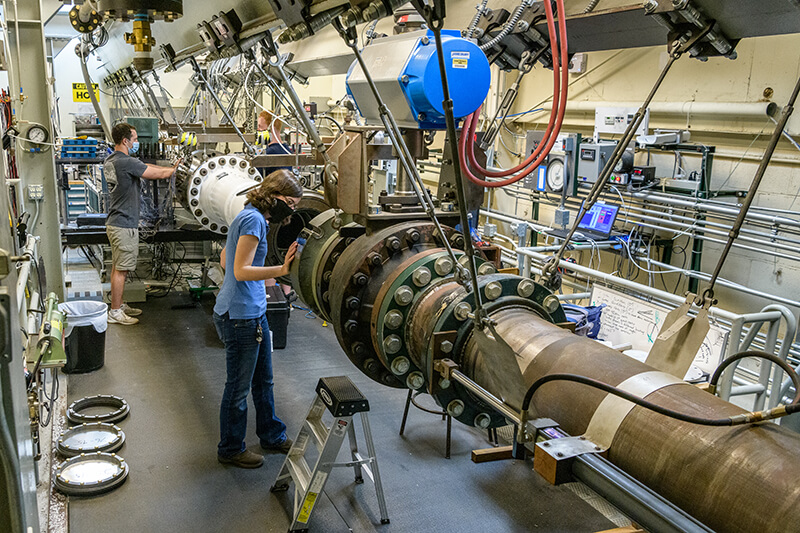October 27, 2020
Purdue University kicks off multidisciplinary program to sharpen focus of hypersonic flight

Students work during the summer with Purdue’s Mach 6 quiet wind tunnel. The tunnel will be involved in research by a new multidisciplinary hypersonics program. (Purdue University photo/John Underwood)
WEST LAFAYETTE, Ind. — Purdue University and the University of Notre Dame are pairing their extensive hypersonics research and facilities to improve the technology’s next generation of high-speed vehicles capable of flying at Mach 5 and beyond as part of a $5.8 million program supported by the Air Force Research Laboratory (AFRL).
The two university multidisciplinary effort lays the groundwork for Purdue’s continuing role in one of the U.S. Department of Defense’s top modernization priorities.
Both universities are home to separate Mach 6 quiet wind tunnels as well as unique combustion facilities. The 16-member faculty team from both universities will experiment, model and simulate propulsion systems, air flow, heat transfer, and overall design of the flight vehicles.
Dan DeLaurentis, director of the Institute for Global Security and Defense Innovation (i-GSDI), said multidisciplinary teams are essential for the future of hypersonics research.
“Disciplines including aerodynamics, aerothermal effects and propulsion all can come into play when a vehicle is flying at hypersonic speeds,” he said. “Multidisciplinary research is a point of emphasis for the i-GSDI and the Department of Defense.”
Jonathan Poggie, a Purdue professor of aeronautics and astronautics, will lead the hypersonics program.
“The role of our research is to provide support to military and NASA, providing them the research needed to make more accurate predictions about some of their toughest hypersonic problems,” he said. “We will provide insight into extreme heat loads, aerodynamic forces and unpredictable control characteristics interacting with a vehicle when it flies at such high speeds.”
Mach 5 is five times the speed of sound, or more than 3,500 mph at sea level.
The research includes inlet and external flow performance in quiet flow wind tunnels, directed by Joseph Jewell, assistant professor of aeronautics and astronautics at Purdue, and Thomas Juliano, associate professor of aerospace and mechanical engineering at Notre Dame. Reducing uncertainty in turbulent flow modeling will be handled by Sally Bane, Purdue associate professor of aeronautics and astronautics. DeLaurentis will direct model-based systems analysis for hypersonic vehicle design, and Carson Slabaugh, Purdue assistant professor of aeronautics and astronautics, will lead scramjet combustion experiments. Key to the effort are the unique experimental facilities at the two universities.
Purdue continues to establish itself as a hub of hypersonic capabilities research, most recently with announcements that the university had received funding to develop the first-ever Mach 8 quiet flow wind tunnel and has obtained a Hypersonic Pulse (HYPULSE) shock tunnel donated by Northrop Grumman.
Purdue has one of the most comprehensive hypersonics research capabilities in the country, with nearly 40 world-renowned researchers in hypersonics, with expertise in navigation, aerodynamics, aerothermal effects, propulsion, autonomy, system engineering, high-temperature materials, and manufacturing. Purdue’s research also includes an agreement with Johns Hopkins Applied Physics Laboratory for collaborative research on hypersonic materials, guidance and navigation control systems and sensors. It adds to Indiana’s research in related fields, including the University of Notre Dame’s research in aerodynamic effects, Indiana University’s modeling and simulation research, and the Naval Surface Warfare Center, Crane Division’s engineering, testing, and modeling capabilities.
“The Mach 6 quiet wind tunnel was the seed that got things started. All around the university there are many leading experts interested in the field of hypersonics,” Poggie said. “We were able to put together a really great team because we have such talent and interest.”
In July 2019, Purdue hosted the inaugural NDIA Hypersonics Capabilities Conference, which brought military, government, congressional, industry and policy leaders to further advance U.S. hypersonic systems. Purdue also recently announced a HYPULSE shock tunnel donation from Northrop Grumman Corp. Once assembled, Purdue will be the only university in the U.S. to offer such hypersonics aerodynamics and propulsion testing capabilities.
About Purdue University
Purdue University is a top public research institution developing practical solutions to today’s toughest challenges. Ranked the No. 5 Most Innovative University in the United States by U.S. News & World Report, Purdue delivers world-changing research and out-of-this-world discovery. Committed to hands-on and online, real-world learning, Purdue offers a transformative education to all. Committed to affordability and accessibility, Purdue has frozen tuition and most fees at 2012-13 levels, enabling more students than ever to graduate debt-free. See how Purdue never stops in the persistent pursuit of the next giant leap at purdue.edu.
Writer: Brian Huchel, bhuchel@purdue.edu. Working remotely but will provide immediate response.
Sources: Jonathan Poggie, jpoggie@purdue.edu. In addition to phone interviews, the professor is available for interviews via WebEx.
Dan DeLaurentis, ddelaure@purdue.edu. The professor is available for interviews via phone.
Note to Journalists: A photo of Purdue’s March 6 quiet wind tunnel is available on Google Drive.

